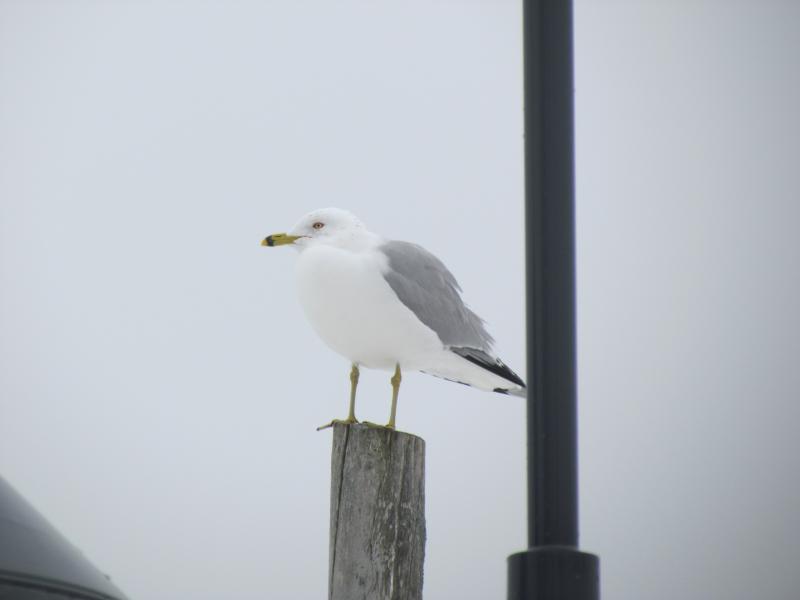We know. “Enough already with all the gulls,” is what you’re probably saying. But we can’t help it, we find them fascinating.
Today we want to highlight a common gull species here in Maine that many people never realize is something different from the ubiquitous herring gull. Because it is rather similar in appearance to that well-known gull, the ring-billed gull could be said to be hidden in plain sight—at least for the casual observer.
The truth is, the ring-billed gull is quite easily differentiated from the herring gull in most circumstances. True, the adult ring-billed gull shares the adult herring gull’s gray back with black wing tips; white head, body and tail; and the bright yellow bill. But from here, the differences start to mount up. Take the size difference as a start: the ring-billed gull is only about half as big as a herring gull. The difference is readily apparent when they are sitting near each other but can be harder to determine when the two species are not close enough to compare. Sometimes people assume that the smaller ring-billed gull is a “baby” herring gull. But young gulls (like all birds) are the same size as adults when they get big enough to fly away on their own, so a smaller but similar-looking bird is unlikely to even be of the same species as its larger look-alike.
An often easy feature to see on an adult ring-billed gull that is strikingly different from an adult herring gull: the bright yellow legs. Remember that herring gulls have pink legs. Finally, adult ring-billed gulls, as their name implies, have a black ring that encircles the yellow bill. But beware that herring gulls can sometimes (especially in their third year before they reach full adulthood) have a black ring or black spot on the bill as well. In that case, it’s best to focus on the size of the bill—a big, stout one in herring gull and a shorter, relatively more petite bill in the ring-billed.
We’ve focused on the identification features that can be used to separate adults of the two species, but immatures are a little harder to distinguish, especially since herring gulls pass through three years of different immature plumages and ring-billed gulls, two years, before reaching adult plumage. We will let those of you who wish to know more about separating immature gulls study up in your favorite gull identification guide but remember that the size difference between the two species is your best identification clue at any age.
Even active birders who can tell the two species apart at a glance may be surprised to know that the ring-billed gull became a common year-round resident in the state only since the early 1970s. Before the 1950s, the species was largely confined as a breeding species to the western Great Lakes and westward to parts of southwestern Canada and the adjoining northern central U.S. A few nested in Newfoundland and Labrador, and historically probably through the St. Lawrence and Maritimes. Through the 1950s and 1960s, ring-billed gulls began increasing in numbers and expanding eastward to take back their former range.
By the 1970s, numbers of ring-billed gulls found in Maine during migration and winter began to take off with hundreds and then thousands regularly counted. Now it is not at all unusual to see many hundreds of ring-billed gulls (especially in late fall and early spring when many are migrating to their breeding grounds) feeding for worms or other foods on farm fields. And there are always small groups of them lingering around through the winter, especially along the coast or up major rivers where there are cities. In 1981 the first nesting of the species was documented at Lake Umbagog in Oxford County. Twenty years later, a second nesting colony was found way up in Aroostook County on Long Lake near St. Agatha. Now that the second Maine Breeding Bird Atlas has started, we will find out if more are nesting anywhere in the state.
Jeffrey V. Wells, Ph.D., is a Fellow of the Cornell Lab of Ornithology. Dr. Wells is one of the nation's leading bird experts and conservation biologists and author of “Birder’s Conservation Handbook”. His grandfather, the late John Chase, was a columnist for the Boothbay Register for many years. Allison Childs Wells, formerly of the Cornell Lab of Ornithology, is a senior director at the Natural Resources Council of Maine, a nonprofit membership organization working statewide to protect the nature of Maine. Both are widely published natural history writers and are the authors of the book, “Maine’s Favorite Birds” and the newly published “Birds of Aruba, Bonaire, and Curaçao” from Cornell Press.































